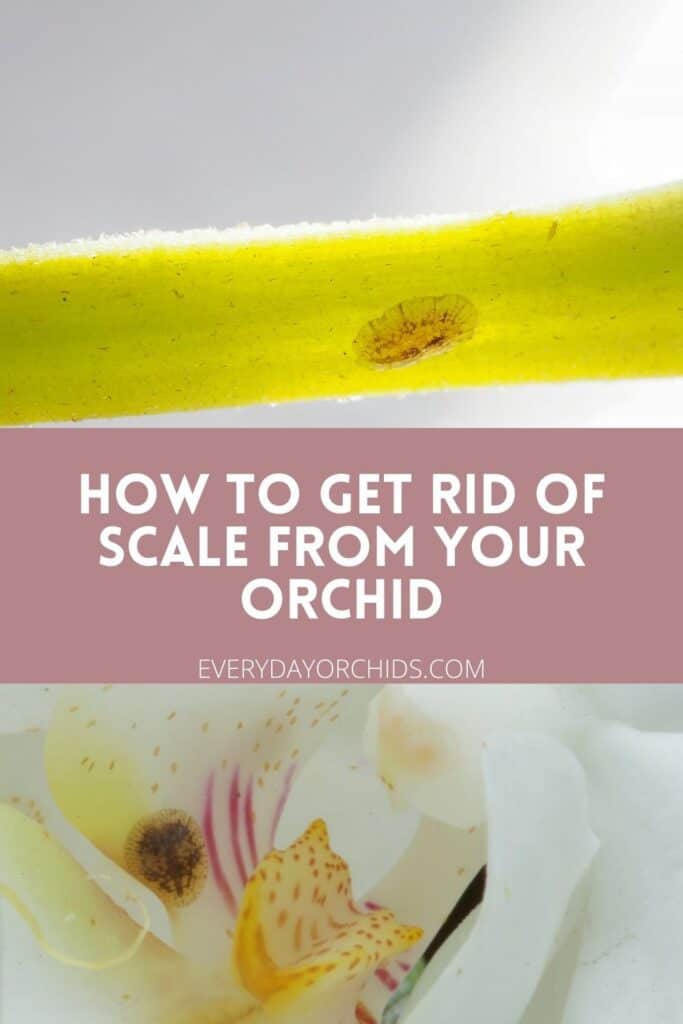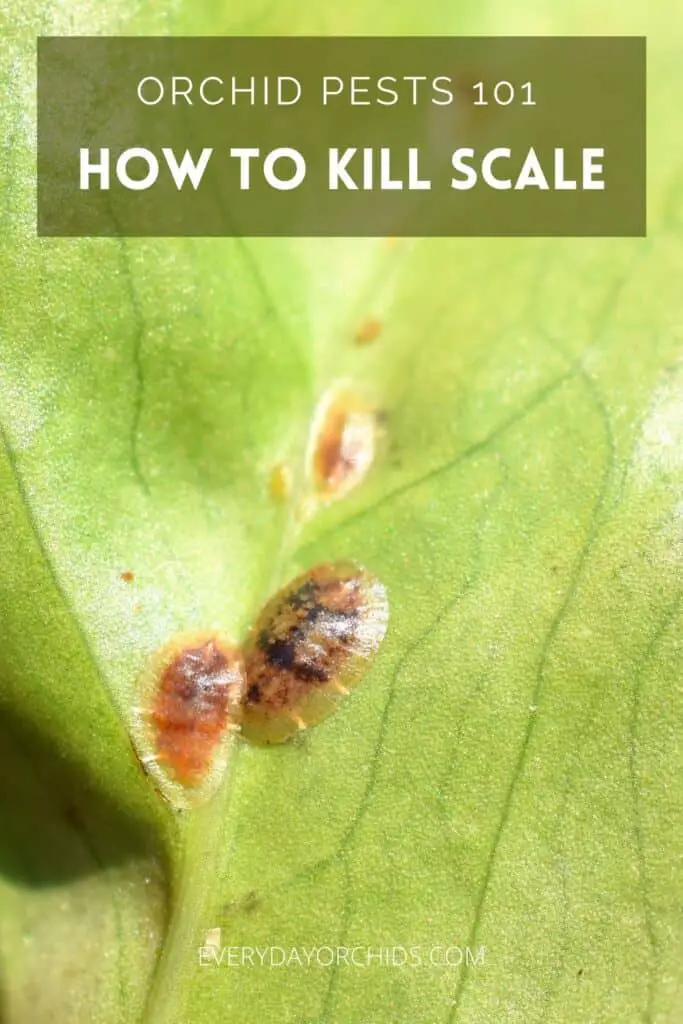Scale is one of the more common orchid pests that you may encounter when caring for your orchid. You will need to act fast to get rid of scale. Minor infestations can be easily dealt with using a few home remedies, while more widespread infestations may need commercial products to eliminate these pests.
To get rid of scale from your orchid, your options are to use rubbing alcohol or horticultural oils such as Neem oil for minor infestations. For larger infestations, use an insecticidal soap spray or insecticide to kill the scale.

In this article, I’ll talk about scale in more detail, including how to identify them and how to tell if you have a scale infestation on your orchid. You’ll learn how to deal with a scale infestation and keep it from coming back. Keep reading to learn more.
Please note that these links are affiliate links and as an Amazon Associate, I earn from qualifying purchases. Purchases made through affiliate links in this post may generate commissions at no additional cost to you. Use this link for a discounted Amazon Prime trial. Thank you for your support!
Table of Contents
All About Orchid Scale
Not to scare you, but you need to take scale infestations seriously. Scale is one of the most destructive pests out there. It sucks the sap and nutrients out of the orchid plant. Left untreated, the orchid leaves wither and turn yellow. Over time, the entire plant dies.
Scale is a common pest that attacks not just orchids, but many different types of houseplants. There is actually more than one type of scale out there. In fact, there are over 20 different types of scale that can infest your plants. Boisduval scale has been known to attack Cattleya and Vanda orchids. Brown scale commonly affects Phalaenopsis and Jewel orchids, among others.
There are also soft scale and hard scale varieties. Soft scale damages orchid plants by sucking the sap and nutrients from the orchid’s leaves and tissues.
Soft scale also excretes honeydew, a sticky residue. This tends to lead to other problems, such as sooty mold and attracts ants to the orchid. Hard scale do not leave behind honeydew, but this does not make them any less problematic for the orchid grower.
Life Cycle Of Scale
Like many other orchid pests, scale have three main parts to their life cycle: egg, larvae or immature nymph, and mature or adult scale.
The cycle begins when an adult female scale lays eggs under her shell. The eggs remain protected under the shell until the mother dies.
Eventually, the scale cover breaks, allowing to the eggs to hatch and nymphs to emerge. The nymphs crawl around until they find an ideal feeding location. Once there, they will settle down and feed until they reach adulthood. During this time, as the scale progresses from nymphs to adults, they will form a protective outer covering.
The life cycle of a scale is short, lasting as little as 2 or 3 weeks in ideal conditions, such as indoors or in a greenhouse. Warmer weather will also shorten the life cycle. In regular conditions, the life cycle can be as long as 1 month.
While the life cycle is relatively short, the problem is that each cycle produces numerous female scale. Each female scale goes on to lay hundreds, if not thousands, of eggs. In no time at all, the scale population can quickly explode into a serious infestation.
What Scale Looks Like On Your Orchid
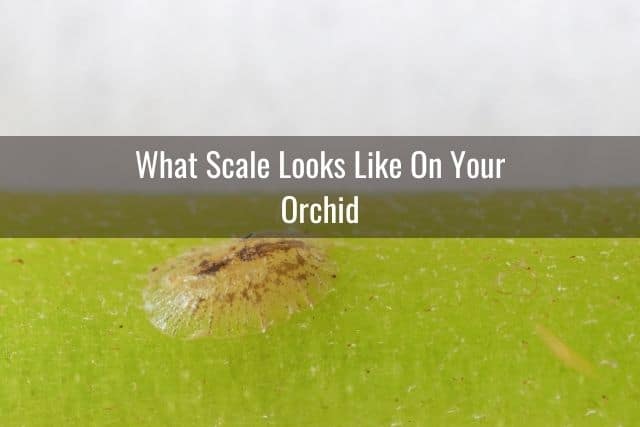
By the time you notice a scale infestation on your orchid, most likely the scale are already in the mature, or adult, phase of their life.
Adult scale appear as white, yellow, tan, or brown oval or circular discs on your orchid. They will attach to any and every part of your orchid, including the leaves, the pseudobulbs, flower spikes, roots, and flowers. They often hide in the dark, cooler areas of the orchid, such as on the underside of leaves or in the sheaths and crevices of orchids.
Scale can range in size from 1 to 5 mm in diameter. Immature scale are tiny and difficult to see with the naked eye. They present as yellow or pink specks, crawling along the potting media or the orchid. Without a magnifying glass, it is easy to miss seeing immature scale. This is why it is easy to unknowingly bring home an orchid already infested with scale.
In addition to the actual scale, you may also notice your orchid’s leaves are wilting or drooping or turning yellow. If you have the soft scale that excretes honeydew, you may notice some sticky sap on your orchid. Sticky sap, or honeydew, that has been left on the orchid for a longer period of time can turn black, due to sooty mold. These are all signs of a scale infestation.
Ants may also be attracted to the honeydew and congregate on your orchid. Ants have been known to farm scale and use them to create the honeydew that these ants eat.
Note: As I mentioned earlier, there are over 20 different varieties of scale. In some cases, a large infestation of male scale will appear as a powdery white covering on your orchid’s leaves or stem. Sometimes this can be mistaken for mealybugs. Male scale are smaller and not always round, brown or disc-shaped. In contrast, female scale are larger and form the hard disc-shape that eventually will protect the eggs.
How Did My Orchid Get Infested With Scale?
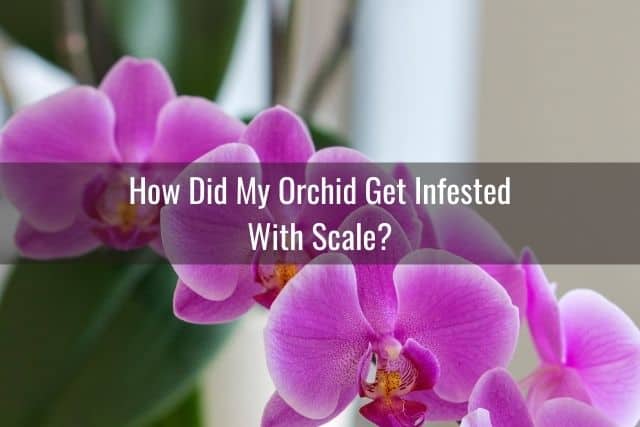
This is a top question for orchid growers: How did scale get on the orchid in the first place?
Most likely, the orchid was already infested with scale at the store. Immature scale can be very difficult to spot. As a result, you may have brought home an orchid infested with scale without even knowing it. It is for this reason that I always recommend isolating new plants for at least 2 to 4 weeks upon bringing them home.
It can take days before a pest infestation is noticeable. If you happen to put your new orchid with the rest of your plant collection too early, or without a quarantine period, there is a chance that the scale could spread to your other plants as well. Obviously, this creates a more widespread infestation and more work for you.
Mature scale will crawl from plant to plant. This is how scale spreads from an infested plant. If a healthy, uninfected plant is placed in close proximity to an infested plant, the scale will be able to move to the new, healthy plant. This can happen easily in settings where orchids are placed close to other orchids and plants, such as in the grocery store, flower shop, or greenhouse.
Scale can travel via air currents. Outdoors, this is a common way for scale to be transferred between plants. Wind and air currents carry the scale around the garden, allowing them to infest new plants. This may be how your outdoor orchids became infested with scale. Likewise, greenhouses often have large fans positioned around the room, circulating air. These air currents within the greenhouse also make it easier for pests to travel and infest new plants.
How To Deal With A Scale Infestation On Your Orchid
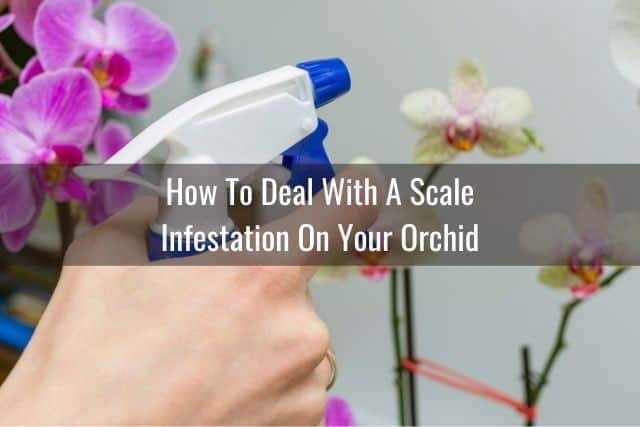
Once you discover that one or more of your orchids is infested with scale, you need to take action immediately. Scale infestations can spread rapidly. Left untreated, it can kill your orchid. Here are some key steps you need to take if your orchid is infested with scale.
Isolate Your Orchid
First things first, isolate the affected orchid(s). Since you now know that scale can travel and spread with the help of air currents, I would advise you to isolate your infested orchids in a separate room away from other plants.
It may be tempting to put the orchids outside and leave them there. After all, who wants pests in their house? However, putting your scale-ridden orchids outside can backfire on you, as the scale takes advantage of this and spreads to the rest of your garden. Additionally, air currents outdoors can bring scale back to your orchid, causing a reinfestation of these pests.
Treatment Options For Your Orchid
Depending on how severe or widespread the scale infestation is, you can treat the scale using a variety of methods. I’ll cover some treatment options, going from the simplest and cheapest option, to the more complicated, store-bought options.
Be aware that no matter which treatment method you use, you will most likely need to do repeated treatments or applications until you can confirm that the scale is all gone. You may also need to do a combination of the treatments below to get all the scale eradicated.
Rubbing Alcohol
Rubbing alcohol, or isopropyl alcohol 70%, is one of my favorite ways to deal with orchid pests. It can be used to treat some of the more common orchid pests, including mealybugs. It is readily available in the first-aid section of many stores and is relatively inexpensive. This method is most effective at manually removing adult scale.
Taking a cotton ball or cotton swab soaked in rubbing alcohol, gently wipe down the leaves and parts of the orchid where you see scale.
Alternatively, if the scale are stuck on your orchid and not coming off, you can use a soft-bristled toothbrush dipped in rubbing alcohol. Use this to manually remove the scale from your orchid. Throw away the toothbrush afterwards. Do not save it for next time, just in case scale eggs or nymphs survived and are hiding in the bristles.
Follow this with a rubbing alcohol spray. Fill a spray bottle with a 50/50 solution of rubbing alcohol and water. Spray down the orchid using a fine mist spray nozzle. This will ensure that you get the nymphs or immature scale that you can’t easily see. Do this at least once a week until the scale are gone.
After spraying down your plant, be sure to remove any excess water from the orchid’s crown. This will help prevent problems with crown rot later on.
One drawback of using this method is that rubbing alcohol can be very drying to the orchid. It can damage the plant tissue if used too much or too frequently. Used occasionally and in small amounts to deal with minor pest infestations is fine.
However, if you find that you are needing copious amounts of rubbing alcohol to manage a scale or other pest infestation, that is probably a sign that it isn’t working and you need to try another treatment.
Neem Oil
Neem oil is a natural, non-toxic product you can use to deter pests on your orchid. It is derived from the seeds of the Neem tree and is safe to use in your home, even among children and pets.
Neem oil works by smothering and suffocating the scale so that they can’t move or breathe. It disrupts the egg and larval stages of the pest’s life cycle, preventing growth and further reproduction from happening. It is most effective on the nymphs and crawler scale.
To use Neem oil on your orchid:
- Mix 5ml (1 teaspoon) of Neem oil with 2.5 ml (1/2 teaspoon) gentle dish soap (such as Ivory soap) in 1 quart of warm water.
- Mix or shake well. This will emulsify and evenly disperse the oil.
- Pour the solution into a misting bottle with a fine mist spray nozzle.
- Using the fine mist nozzle, spray this solution all over your orchid. Make sure you get the underside of the leaves and all the nooks and crevices that scale might be hiding in.
- Spray down the potting media as well.
- Repeat this every few days, each time with a new batch of Neem oil solution. Do this until all the pests are gone.
I would recommend using Neem Bliss’ organic cold-pressed Neem oil. This has a high azadirachtin content, making it especially effective against scale and other orchid pests. You will need to mix this with water and make a spray solution.
If you are looking for something ready-to-use, try Bonide’s Neem Oil. It comes already diluted and in a spray bottle. I’ve also used this product and find it very convenient and easy to use.
Neem oil is a fantastic, non-toxic, natural pest control method for orchids. One key thing to remember is to use this in the mornings and keep your orchid out of direct sunlight to prevent burning. Avoid using this on hot days. To learn more, read this article about neem oil and how to use it on orchids.
Insecticidal Soap Spray
For more serious scale infestations, you may want to use an insecticidal soap. Soaps work by breaking down the waxy, protective coating on the scale (and other pests). This makes them more vulnerable to the insecticides and kills them off.
When using an insecticidal soap, be aware that it can potentially damage young or new orchid tissue. In addition, you want to keep your orchid out of direct sunlight for several days following application. This will help prevent burns and sun damage on the orchid leaves.
Needless to say, you’ll also want to avoid watering your plant on the same day you apply the insecticidal soap spray. Otherwise you risk washing away the insecticidal soap.
There are a few different insecticidal soap sprays available on the market. With any of these soap sprays, I would recommend testing a small area on your orchid first before you spray down the whole plant.
- Safer Brand Insecticidal Soap kills soft scale and many other pests. It can be safely used on orchids. This is safe to use for organic gardening and around children and pets. You may need to reapply every 7 to 10 days until all the scale is gone.
- Bonide’s Ready-to-Use Insecticidal Soap. This targets scale and many other orchid pests, including aphids, spider mites and mealybugs.
- Natria Insecticidal Soap is good for scale and many other pests. Much like the other insecticidal soap sprays, it is safe to use around children and pets, and you may need repeated weekly applications.
When you are ready, bring your orchid outdoors to a well-ventilated area. Do this on a cooler day, where daytime highs will not exceed 80 degrees Fahrenheit. This is to prevent damage to the leaves from the sun and heat.
Spray the orchid down with this soap solution thoroughly, until the every nook and cranny is sprayed. Spray until the orchid is saturated, nearly dripping with the insecticidal soap spray. Do this every few days, until the scale is gone.
Insecticidal Spray
For an incredibly severe or widespread scale infestation, insecticidal sprays containing orthene, malathion, diazinon or carbaryl are an option.
If you are reaching for an insecticidal spray, chances are you have a pretty serious scale infestation on your orchid. In this case, bring your orchid outside to do the treatment. Insecticidal sprays are best used in well-ventilated areas, away from pets and children. Before going ahead with the full treatment, test a small section of your orchid first.
Some examples of insecticidal spray include:
- Ortho Max Malathion Insect Spray.
- Spectracide Malathion Insect Spray.
- Bonide Malathion Insect Control.
All of these products are sold in the concentrated form. You will need to follow the package directions and dilute it in water before use. In addition, these products are to be used outdoors only. Once you have the diluted product ready, pour it into a spray bottle with a fine mist nozzle.
Then, bring your orchid outdoors in a well-ventilated area, away from pets and children. Do this on a cooler day, where temperatures will be below 80 degrees Fahrenheit.
Using the insecticidal spray, spray your orchid down thoroughly, making sure you get the underside of the leaves, any crevices that the scale may be hiding in, and the potting media.
Do this early in the morning and out of direct sunlight. Avoid watering your plant on the same day that you apply the insecticidal spray.
Keep the orchid in a cool, shaded protected location for the rest of the day. Allow the plant to fully dry off before bringing it back in at night. You may need to repeat this treatment in a week if you still see scale on your orchid.
Natural Predators
This is more applicable to outdoor orchids, but if you keep your orchids outdoors, you can use natural predators to help deal with the scale infestation.
Ladybugs, lacewings, and wasps are a few examples of natural predators that target scale. This treatment option may be harder to manage because, obviously, the ladybugs and other natural predators can fly away and leave without killing any scale. I personally have not used this method, but am just putting it out there as another option.
Continue To Isolate The Orchid
Even after you have treated your orchids for scale, continue to isolate them for an additional 2 to 3 weeks. This will take you through a full scale life cycle, allowing any straggler eggs or nymphs to grow into adults. Once they are adults, they will be big enough for you to spot and remove.
Remember, any surviving scale pests have the potential to grow up and cause another infestation. By continuing to isolate your orchid, you will be able to really make sure that you have dealt with and eradicated the scale population in your orchid.
Repot Your Orchid
After you have removed all the visible scale you can find, it is a good idea to repot your orchid into fresh potting media. If you have had a large scale infestation, there is a good chance that there may be scale amongst the orchid roots.
Immature scale and scale eggs can also hide in the potting media. These are so small that you won’t be able to see the eggs or immature scale with the naked eye. If you leave your orchid in the old potting media, there is a chance that as the eggs hatch and immature scale grow up to become adults, your orchid will be “reinfected” with scale.
By repotting the orchid into new orchid potting media, you’ll be able to ensure that you’ve gotten rid of the scale eggs and immature scale hiding in the orchid bark. For good measure, make sure you rinse out the roots during the repotting process and get rid of any old bark clinging to the roots.
It also goes without saying, but when you repot your orchid, use a new or sterilized orchid pot. Don’t simply reuse the old pot without cleaning and sterilizing it.
The whole purpose of doing all this is to make sure that you get rid of all the orchid scale, including the eggs and immature scale. Reusing the same old pot without sterilizing it has the potential to reinfect your orchid and defeats the purpose.
Preventing Scale Infestations On Your Orchid
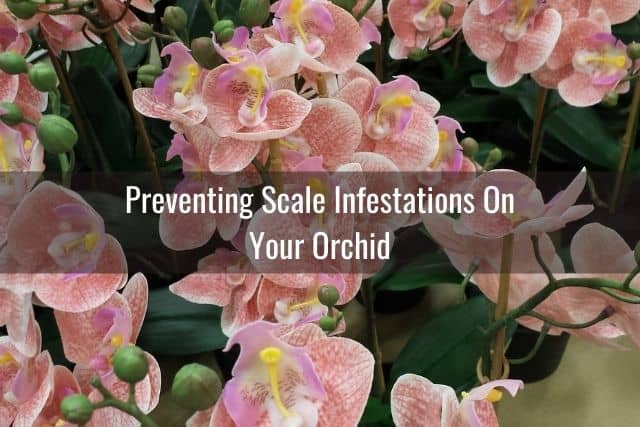
While it may not be possible to completely prevent scale from ever affecting your orchid, there are a number of things you can do to minimize the chances your orchid will have a scale infestation.
- Isolate all new orchids and other plants. Do this for at least 2 to 4 weeks. During this time, keep an eye out for any emerging pest infestations or diseases.
- Regularly inspect your orchid collection for any new signs of a pest infestation or disease. Spotting problems early on will allow you to deal with the problem before it gets out of hand.
- Space plants apart. Don’t allow neighboring orchids to come into contact by means of overlapping leaves or pots in close proximity. Keeping the plants well-spaced apart will also go a long way in maintaining air movement between the plants and preventing mold and fungal infections.
- Minimize air currents. If you have recurring problems with scale, take a look at how air moves and circulates in your plants’ room. If you are using a fan, it may be that the air currents are carrying scale between plants, causing reinfestations on your orchid.
Final Thoughts
It’s always stressful to find pests on one or more of your orchids. If you find scale on your orchid, move fast. Isolate the affected plant and start treatment right away. If you are able to catch it early, chances are, you’ll be able to stop the scale infestation before it gets worse or affects other orchids.
Start with rubbing alcohol or Neem oil if you have a minor infestation before moving onto insecticidal soaps and sprays. Repeated treatment once a week may be necessary until all traces of the scale are gone. Even after you are done treating, keep your orchid isolated for another 2 to 3 weeks until you are certain that there are no more eggs or nymphs hiding.
Best of luck treating your orchid’s scale infestation. It may seem daunting, but you can do it. I hope this has helped you. As always, happy orchid growing!
If you enjoyed this article, please pin it and share!
